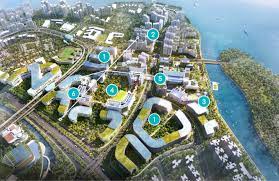
Photo: James Tan/Cities Today
Singapore addresses workforce shortages with automation
12 December 2023
by Sarah Wray
In Singapore’s buildings of the future, turnstiles and lifts will open automatically for food delivery robots, heating and cooling systems will be constantly optimised for energy efficiency, and residents will be able to enter and pay for goods with just their faces.
At Smart City Expo World Congress in Barcelona last month, James Tan, Director of both the Smart City Technology Division at Singapore’s Government Technology Agency (GovTech) and the Smart District Division at industrial development agency JTC Corporation, demonstrated the technical backbone that is making this possible.
The Open Digital Platform, which is a joint development by GovTech and JTC, ingests various types of data and allows disparate systems that use different communication technologies to ‘talk’ to each other. The platform uses machine learning and artificial intelligence (AI) to enable real-time changes. For example, cleaning services and cooling can be automatically increased when high footfall is detected. Lights, water coolers and air conditioners can be powered down without human intervention when the building is empty.
In addition, a digital twin visualises data so developers can run simulations before implementation.
Tan says workforce challenges were one of the key starting points for the platform, with the city-state grappling with an ageing population and low application rates for some public sector positions.
“Facilities management is not a glamorous job,” said Tan. “Everybody wants to be a programmer, the youngsters want to be YouTubers. Nobody wants to do [facilities management].
“So, we try to automate our systems as much as possible.”
In addition, more than 60 percent of facilities managers in Singapore are over the age of 50, according to Tan, who says the platform can make their roles less physically demanding.
“It allows us to have a minimal amount of people in the command centre and less people on the ground to manage our city and estate systems,” he said.
Smart district

The ODP is currently deployed at the JTC Summit office and at the Woodlands North Industrial Park. It will next be deployed at Singapore’s Punggol Digital District, a 50-hectare technology business park that is scheduled to open from next year.
The goal is to eventually roll the platform out across all JTC’s estates and potentially beyond: the Punggol Digital District is described as a “microcosm of Singapore’s smart city aspiration”.
The platform has so far been integrated with building systems such as access control, air conditioning and ventilation, escalators and lifts.
Through integrating gantry turnstiles and lift management with a food delivery application, the ODP can act as a “traffic control management system” for autonomous delivery robots, authorising their entry and guiding them through the building.
Singapore estimates that centralising operations in this way will reduce operational manpower needs by 50 percent and progressively lower energy and water consumption by 30 percent, compared to the national average.
“We can use the traditional rules-based approach to do some optimisation but that’s not going to squeeze the last drop,” said Tan. “Each small system contributes data – CCTV, turnstiles and lifts are all helping. Every little bit will help us make the AI become smarter to optimise.”
Pay with your face

GovTech and JTC are creating a “central identity” where people can not only gain access to facilities via facial recognition, but also pay for goods and services. The system brings together the facial recognition system provider, the payment gateway, and the vendor’s point-of-sales application.
“It reduces a lot of friction,” said Tan. “If you’re carrying a lot of things, you don’t need to bring anything; you can just show your face.”
The ODP’s utility also extends beyond building management to address broader urban challenges. For example, it can support public transport planning, management for security-protected areas like Jurong Island, flood monitoring through automated alerts, and capacity planning for electric vehicle chargers.
There is a push to bring more services into the platform over time across areas such as buildings, mobility and education. An assisted living wireless alarm system for older residents living alone is currently being migrated to the ODP following a proof of concept.
Citizens aged 65 and above make up almost a fifth of Singapore’s population.
“We don’t really have a lot of people to take care of the elderly,” said Tan. The wireless system alerts a contact centre and neighbours when help may be needed.
As well as bringing more use cases and departments on board, GovTech and JTC also want to engage developers to build and integrate services via open APIs.
“We want our estates to be like a living lab,” said Tan.
“This platform gives us the versatility to bring all the data into a central place. All the datasets are also available as open data so companies can build applications for taxis, buses, car parks or air quality.”
A large language model ChatGPT-style chatbot is now being developed so users can ask questions and have them answered rather than having to look at dashboards.
Challenges
While political stability in Singapore mitigates some concerns about shifting priorities when leadership changes, this is still a potential challenge for such a long-term initiative with incremental costs.
“We need runway to complete our project,” Tan said.
Another challenge is convincing people to embrace digitalisation and justify the costs associated with such transformative projects.
Tan said it’s important to highlight the value that is being added, rather than focus on the technology itself.
Connecting more systems, including physical ones, can also raise cybersecurity concerns.
Tan commented: “In addition to standard cybersecurity risk mitigation measures, we also have in place a risk matrix that assesses the potential impact – physical harm vs. nuisances – of compromised systems. For example, for those that can cause physical harm, no actuation is allowed or if that is needed, we will put in cybersecurity measures to cut off its access from the internet.”
He added: “As a basic design principle of the Open Digital Platform, we also look into ways to actuate controls non-intrusively in consideration of operational safety in facilities management. For example, we can call for lifts but not close doors or force stop a lift. Another example is a ‘strict no control’ of escalators in view of the physical danger that can be caused by sudden stoppage or power supply cut-off.”






